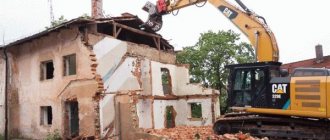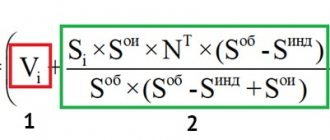What is the division of buildings and premises into new premises?
In the field of construction and real estate, only division into homogeneous objects is allowed. Therefore, it is impossible to divide the building into premises, due to their fundamentally different legal status. However, in fact, the building is divided into separate rooms during construction or during subsequent operation. This procedure consists of limiting certain areas with walls, partitions, ceilings, and other structural elements.
The building can also be divided into temporary parts, without any fencing at all. However, such temporary parts will not constitute real estate. Theoretically, the building can only be divided into new buildings, but in practice such work is impossible to carry out, or at significant expense.
The premises can be divided, and as a result of work and approvals, two or more new objects can be formed. The original premises will lose its existence as a real estate object and will be excluded from the Unified State Register of Real Estate with the cancellation of the cadastral number. The option of creating a new premises while preserving the original object is allowed only in the form of a division.
Regulatory acts
The basic rules for dividing real estate are specified in federal legislation. Depending on the type of work, the following will apply:
- GRK RF ();
- Housing complex of the Russian Federation ();
- Law No. 384-FZ ();
- Law No. 123-FZ ();
- Decree of the Government of the Russian Federation No. 87 ();
- Decree of the Government of the Russian Federation No. 468 ().
Coordination of reconstruction or redevelopment takes place at the local level. Therefore, Moscow Government Decrees No. 432-PP, 508-PP, 692-PP will additionally be applied. These governing documents contain not only approval regulations, but also a number of prohibitions on work (they mainly apply to premises in apartment buildings). Also, for design purposes, separate joint ventures, SNiPs and GOSTs will be selected for different types of buildings.
In simple terms
In order for a new property to be formed as a result of division, it must meet the criteria of isolation and isolation. This rule is specified in Law No. 218-FZ and will be checked during approvals, cadastral registration and registration of rights. Isolation consists in enclosing the area of the object from the rest of the building (for example, due to existing and newly erected walls). Separation is confirmed if the premises have a separate exit to the street or to common areas.
The division of buildings and premises can be carried out for the following purposes:
Calculator of the cost and timing of our services - here
- for the formation of new objects with a similar purpose (for example, instead of one large apartment, you can make two small ones);
- for redistributing large areas into several small premises, renting them out or using them for other purposes;
- to differentiate rights between several owners, if determining the shares is not enough for this (for example, if each of the co-owners wants to receive their share in kind);
- for simultaneous change of purpose and repurposing of the building (for example, if you carry out redevelopment and turn large production areas into apartments).
If you just need to temporarily allocate space for different commercial purposes, you can divide it into parts without any construction work or additional approvals. For example, you can “cut” a large retail space into many small retail outlets according to lease agreements and technical plans. Such parts can be placed on temporary cadastral registration for the entire rental period.
Expert commentary. The hardest part is dividing living spaces. In such a situation, it is necessary not only to take into account building safety standards, but also to make separate exits for each newly formed apartment, comply with the requirements for the minimum living space of rooms, and cut new windows for natural light. In non-residential buildings and premises there are significantly fewer restrictions. In addition, for non-residential objects, decisions are made only by the copyright holders themselves, and when working in apartment buildings, approval from the general meeting is required.
One of the mandatory conditions of the division is compliance with the signs of isolation and isolation, the presence of a separate entrance to each room
How to arrange the formation of premises
The creation of new premises within the boundaries of the building occurs by decision of the owner. Accordingly, if non-residential premises are divided into several new objects, such a decision must be expressed by all owners on the right of shared ownership.
The results of construction work, after drawing up the act, must be recorded in the technical plan. To do this, the owner of the object performs the following actions:
The information in this article contains general information, but each case is unique. You can get a free consultation from our engineers using one of our telephone numbers - call:
All consultations are free.
- after signing the act, you need to apply for the preparation of a technical plan of the building, as well as each changed or created non-residential premises;
- the engineer carries out cadastral work - requests USRN information and archival documentation of the BTI (technical passport of the building and premises, floor plans, etc.) - if necessary, conducts an actual survey of the property;
- as a result of the inspection, the engineer establishes the following parameters - the area and location of each room within the building, the presence of enclosing elements and structures, door and window openings, etc.;
- if a building is registered for the first time with the simultaneous formation of premises, it is necessary to carry out cadastral work on the land plot - surveying will allow determining the location of the building on the site and its coordinates;
- The engineer records the results of cadastral work in the technical plan - a text description of the characteristics is filled in, the resulting premises are reflected on the floor plan of the building, diagrams and drawings are drawn up.
This is important to know: Fine for illegal construction
The technical plan is the basis for applying to Rosreestr - registration occurs at the request of the owner or the parties to the lease agreement. The formation of a premises, division or allotment will be considered completed from the moment the cadastral registration information is entered into the Unified State Register. For each independent property, the owner will receive an extract from the register.
Expert commentary . Starting from 2021, the law obliges each property to be registered - otherwise, any types of transactions will be prohibited. To submit documents to the cadastre in a timely manner and complete purchase, sale or rental transactions, please contact. Our company’s engineers will provide services and carry out cadastral work and land surveying, quickly draw up a technical plan, which will serve as the basis for registration in Rosreestr.
Building codes and restrictions for division into premises
In addition to complying with the rule on dividing buildings and premises into similar objects, there are other restrictions. For example, having divided non-residential premises, you cannot automatically recognize them as apartments and use them for human habitation. To do this, it is necessary to confirm that the object meets the standards for housing (they are specified in the Decree of the State Construction Committee of the Russian Federation No. 2003 and other acts).
There are other restrictions that must be observed when working for the purpose of division:
- for newly formed residential premises, the minimum size of rooms cannot be less than 8 sq.m., and their width cannot be less than 2.25 m;
- it is impossible to make a division into full-fledged real estate objects if it is impossible to ensure their isolation and isolation (according to the criteria indicated above);
- during the division process, all newly formed premises must comply with fire, sanitary, hygienic and other safety standards (for example, a division with a general reduction in living space by increasing other premises, in violation of the “wet zones” rule, and other standards is not possible);
- The section should not worsen the living conditions in other premises of the apartment building, or lead to damage or destruction of the structures of any building.
In most cases, it is impossible to make a division in kind according to the shares specified in the title documents. Also, the work requires the consent or agreement of the copyright holders, and in the MKD - the approval of the residents of the house.
Expert commentary. During design and work, general construction restrictions specified in federal and local regulations must be observed. For example, it is prohibited to dismantle or block ventilation ducts, public utility networks, emergency warning systems and escape routes. All these points will be taken into account by the designers of the Cadastral Moscow company if you choose us for the section.
When can non-residential premises be divided into two premises?
In accordance with current legislation, the division of non-residential premises is possible only if the resulting parts of the object are considered suitable for living. But it is worth considering a small nuance - rooms cannot be divided into shares.
In order for an object to be recognized as residential, it must meet the following requirements:
- The premises have access to heat, water and electricity;
- The room has natural light (that is, there must be windows);
- The area of the property is at least 12 square meters for each owner.
What projects and work are needed to divide buildings and premises
The list of works during reconstruction and redevelopment differs significantly, which will entail different approval procedures. Redevelopment work may include:
- erection, transfer or dismantling of capital walls inside the original premises and along the perimeter;
- combining premises or parts thereof to include their area in a new facility;
- cutting a new exit to the street or to common areas, arranging an entrance group (porch, vestibule, ramps, stairs);
- arrangement, expansion, transfer or sealing of openings for windows;
- relocation of utility networks and plumbing equipment, including the division of their systems into all new premises (this work falls under reconstruction and can be combined with redevelopment);
- facade work associated with the emergence of new objects.
It is important that during the redevelopment the parameters of the entire building will not be changed, i.e. its area, height, number of storeys, and other basic characteristics will remain unchanged.
During reconstruction, on the contrary, the parameters of the building and all its premises may change. Therefore, for the section you can use the same types of work as for redevelopment, as well as:
- adding a new floor or adding an attic volume to newly created premises;
- replacement, restoration and installation of new load-bearing structures (this is especially true for creating walls near newly formed premises);
- extension of an additional part of the building (as a result of such work, additional area can be cut for each new room);
- other types of work in premises and buildings.
As with redevelopment, the reconstruction section should be thoroughly described in the project. For this purpose, architectural, engineering, planning and other solutions are selected and described, calculations of loads and reinforcements are made, structures and materials with the appropriate characteristics are selected.
Calculator of the cost and timing of our services - here
For the division of buildings and premises, it is always necessary to develop and approve a project
Is it possible and how to divide non-residential premises into two rooms?
Real estate transactions are individual, and therefore each of them has its own implementation scheme. Sometimes dividing the room into several parts can solve the problem. We will look at how to divide non-residential real estate into two parts in this article.
Various transactions with residential and non-residential real estate require a variety of legal support. Sometimes it is very difficult to manage shares in large premises. And in this case, the situation can be resolved exclusively through the official division of real estate into two parts.
Step-by-step instructions for dividing a building or premises
Reconstruction and redevelopment are characterized by different approval procedures. If there is enough redevelopment work for the section, i.e. Only the parameters of the premises will change; approval requires:
- conclusion of an agreement between copyright holders, or execution of their written consent to the division;
- obtaining approval through a MKD meeting (this is not required for non-residential buildings);
- project development, obtaining a technical report on the condition of structures (for small apartment buildings);
- submission of documents to the Moscow Housing Institute (this department in Moscow issues approvals for redevelopment work);
- contacting MosKomArchitecture (if changes to the facades are allowed during the division);
- carrying out work strictly according to the project, in compliance with safety standards;
- contacting the Ministry of Housing for inspection after work, signing a commission act.
Next, you need to record that as a result of the division, new real estate objects appeared. For this purpose, technical plans are ordered for each newly created premises. To undergo cadastral registration and enter new data into the Unified State Register of Real Estate, a technical plan with other documents is submitted to Rosreestr. After completing the procedures, information about the newly formed objects, including their new cadastral numbers, will appear in the Unified State Register of Real Estate. At the same time, registration of rights is carried out if this is provided for in the agreement of the owners.
When dividing through reconstruction, the approval procedure will go through the following stages:
- design and working documentation is developed, and its examination is carried out (in the capital, this procedure can be completed through the Moscow State Expertise);
- documents are submitted to Gosstroynadzor to obtain a construction permit;
- Notifications of the commencement and completion of work at the site are submitted to the above department;
- After the reconstruction is completed, you need to contact Gosstroynadzor again and obtain permission to put it into operation.
The remaining formalities for partition through reconstruction will correspond to the redevelopment approvals. It is necessary to conclude agreements between the owners or obtain their consent; it is necessary to order a technical plan for each new premises. After completion of cadastral registration and registration of rights, an extract from the Unified State Register will be issued.
Expert commentary. It is unacceptable to begin work on this section without completing the project and permits. This not only poses a threat to the safety of the building, but also practically makes it impossible to legitimize redevelopment and reconstruction. To avoid any difficulties, order design and approval services from the Cadastral Moscow company.
In this example, two new objects were created from one non-residential premises
Terms and costs of the section
In order to carry out construction work and legalize the division, you need to go through the stage of design, project approval, acceptance of work, and preparation of a technical plan. Only based on the results of these procedures can rights to newly created objects be registered. When determining the duration of each listed stage, the following requirements must be taken into account:
- the lead time for a redevelopment or reconstruction project depends on the complexity and volume of work, as well as on the qualifications and professionalism of the expert organization’s specialists (for example, contact, you can receive a redevelopment project within a few days);
- approval of redevelopment should not exceed 45 days, and correct execution of project documentation will allow you to complete this procedure the first time;
- a construction permit is issued by a supervisory authority, and the period for document verification can reach 2-3 months;
- after construction work has been completed and accepted, drawing up a technical plan will take from 1 day to several weeks (specialists will complete this work in 1-2 days, and in the most difficult situations no later than 5 days).
Expert opinion
Kuzmin Ivan Timofeevich
Legal consultant with 6 years of experience. Specializes in the field of civil law. Member of the Bar Association.
According to the rules of Federal Law No. 218-FZ, cadastral registration and registration activities are carried out within the framework of one procedure. It will take 10 days. If the documents are sent immediately to Rosreestr, or 12 days when applying through the MFC.
The cost of the work of designers and cadastral engineer is determined based on the volume and urgency of the order. To find out details of cooperation with, including prices for the design of the project and technical plan, call the numbers listed on the website.
Where do you need to agree on the division of buildings and premises into new premises?
To coordinate the division of buildings and premises, you need to contact the following services:
- MZHI - for redevelopment;
- MosKomArchitecture - for redevelopment and reconstruction if the facades are changed;
- Gosstroynadzor - if the division is carried out through reconstruction;
- BTI - to make changes to the technical passport of the building;
- Ministry of Emergency Situations, SES (Rospotrebnadzor) - these departments check the project for compliance with safety standards, participate in inspections of newly formed premises;
- Rosreestr - carries out cadastral registration and re-registration of rights.
Only a reconstruction project should be submitted for examination. Additional permits will be required if the building is classified as a cultural heritage site.
In this case, when dividing the premises, isolation and separation were not achieved. therefore, part of the property can be rented out and placed on temporary cadastral registration
How to divide non-residential premises into two separate ones?
But cadastral documents can only be obtained after the owner contacts the authorized bodies and registers the premises with the cadastral register. As soon as the application is reviewed, a cadastral document will be issued for each individual part of the property, which is the result of registering the property.
In addition to the cadastral passport, other documents are also required. In particular, since 2012, in order to put a premises on the cadastre, it is necessary to initially obtain a technical plan of the building with a specific premises marked on it, which will be subject to registration. Only a qualified cadastral engineer can make this diagram, but on the condition that he has the ability to reserve his actions using an electronic digital signature.
A technical plan can be submitted for registration in 2 options:
- The specialist sends the plan using the official Rosreestr portal. In this case, he will be required to endorse the document with his electronic signature;
- The specialist can transfer the plan on electronic media (disk, floppy disk, etc.) to the customer, who independently submits it to Rosreestr. Once again, the cadastral engineer must provide his digital signature before handing over the media to the customer.
This is important to know: The act of accepting the transfer of an apartment under the DDU
At the same time, the rule is established that in the case of dividing a non-residential property, it is necessary to use the second option, in which the customer independently brings the technical plan to the competent authorities.
The owner of the premises or their proxies can act as the customer, but subject to the availability of appropriate confirmation reserved by a notary. Particular attention should be paid to the text part of the power of attorney; it should provide the representative with maximum powers to resolve emerging problems.
Separately, it is worth noting that when dividing the premises, several technical plans must be submitted. Therefore, each plan must be issued for a specific part of the non-residential property. Customers can also provide such plans with the help of multifunctional centers, which are present in almost every large city.
Due to bureaucratic difficulties, situations sometimes arise when registration does not go through on the first try. In this case, it is necessary to submit the request a second time and wait for a verdict from the Cadastral Chamber. It is worth noting that the verification is very serious, and any inaccuracy may cause refusal of registration. Therefore, in order to avoid getting into a similar situation, it is necessary to contact only qualified engineers with an impeccable reputation for drawing up a technical plan.
What to do if the division of non-residential premises is refused?
Having received a refusal to register, the customer will also receive a document describing the reasons for such a decision. After the engineer corrects the document, he is obliged to resubmit it independently using the Rosreestr portal and a digital signature. The review period remains the same and is 18 days. After the deadline, the customer must personally contact the multifunctional center and receive cadastral documents if a positive decision is made.
Once the cadastral documents have been received, the second stage of the process begins. It is necessary to obtain a certificate of ownership for each part of the premises. When submitting, it is worth operating with new data, namely the area of each part of the room and its border. The main basis for confirming ownership is the cadastral passport, which contains information about the division of the object and has a technical plan based on new data.
The last step towards completing the procedure is the application for termination of ownership rights. This application is submitted to the Federal Service for State Registration, Cadastre and Cartography. Gradually, this part of the process is transferred to multifunctional centers. For example, since 2014, Muscovites can submit an application to the MFC.
What documents are needed to approve the division?
To successfully complete the division procedure and achieve positive approvals, you will need:
- title documents for the building and (or) premises;
- agreement between the owners, or written consent from all copyright holders of the object;
- minutes of the MKD meeting with approval of the work;
- redevelopment or reconstruction project, technical report (for apartment buildings);
- expert opinion;
- application to the Moscow Housing Institute for approval;
- construction and commissioning permits;
- BTI registration certificate;
- acceptance committee report;
- cadastral engineer's technical plan.
Our specialists will prepare all the necessary forms for the “turnkey division of buildings and premises” service. Contact us, we have the most favorable conditions!
Calculator of the cost and timing of our services - here
Documentation
To complete the division procedure, the following documents will be required (provided for by Federal Law No. 218-FZ):
Articles on the topic (click to view)
- How is an agreement for the assignment of rights to an apartment under the DDU drawn up?
- What is more profitable: to continue living in a municipal apartment or to privatize it?
- The Supreme Court of the Russian Federation on the redevelopment and reconstruction of premises in an apartment building
- How does a mortgaged apartment become a property?
- Written consent of one of the spouses for the alienation, sale of the apartment and its sample
- What to do with a mortgaged apartment if a decision is made to divorce
- SAC RF: It is impossible to recognize a property as ownerless if the owner has not registered ownership of it
- An application to Rosreestr, which must contain a request to terminate the right of common shared ownership of this non-residential premises and to register individual ownership for each part (in accordance with technical passports). All owners sign the application.
- Agreement on division of premises.
- Title documents for this (original) object.
- Technical and cadastral documents for the original object.
- Extract from the Unified State Register of Real Estate.
- Technical documentation for new objects (parts of non-residential premises).
- Copies of passports (of all applicants).
- Receipts for payment of state duty (separate for each part).
- applications for termination of the right of common shared ownership of non-residential premises
- applications for termination of the right of common shared ownership of non-residential premises
What difficulties may arise when dividing buildings and premises?
When dividing buildings and premises, you may encounter the following difficulties:
- the inability to achieve isolation and isolation of new objects;
- insufficient area of the original premises to comply with building regulations;
- the need for additional work to strengthen or restore the load-bearing capacity of structures;
- the need to conduct surveys on the site for reconstruction, especially if an extension or superstructure with a section is to be made;
- high wear and tear of structures and utility networks, which will require additional repairs and expenditure of funds;
- the need to provide separate exits from each new room.
Not all problems and difficulties during divisions can be avoided, since some prohibitions and restrictions are directly related to the safety of the building. However, even in the most difficult situation, you can count on the help of a professional from the Cadastral Moscow company.
The redevelopment or reconstruction project includes drawings and section diagrams
What is allocation of premises?
When allocated, based on the results of construction work, the original premises retain their existence, but its characteristics change significantly (primarily in terms of reducing the area). At the same time, one or more new premises are being formed, each of which will have its own unique characteristics.
The allocation may be temporary or permanent, but registration of a newly created property will be possible only if there are signs of isolation and/or isolation. The allocation may be temporary in nature - such a conditional object will be considered as an independent unit of accounting only for a certain period (for example, temporary cadastral registration is carried out when part of the premises is allocated for lease).
Expert commentary . The Civil Code of the Russian Federation establishes the possibility of allocating a share in a real estate property at the request of one of the owners. In practice, it is almost impossible to allocate a separate premises in kind, proportional to the size of the share. Therefore, it is actually possible to allocate only part of the premises registered as an independent property.
conclusions
The division of buildings and premises consists of the formation of new isolated and separate objects. The building cannot be divided into rooms, but they can be distinguished due to the total internal volume. Premises can be divided into similar objects by erecting walls and partitions and other structures. The division can be carried out in the form of reconstruction or redevelopment. Both of these types of work require special approvals.
The Cadastral Moscow company offers its services in design, support of approvals for the division of buildings and premises. Detailed information can be obtained by calling the numbers listed on the website.
The following materials were used in preparing the article:
- GRK RF ();
- Housing complex of the Russian Federation ();
- Law No. 384-FZ ();
- Law No. 123-FZ ();
- Decree of the Government of the Russian Federation No. 87 ();
- Decree of the Government of the Russian Federation No. 468 ().
Requirements for allocating premises
When allocating premises, the following requirements must be met:
- the original object will change its characteristics, but will retain the same cadastral number;
- the newly created object will not only acquire a list of unique characteristics, but will also receive a cadastral number after registration with Rosreestr;
- like the division of premises, the allocation can be carried out as a result of redevelopment or reconstruction, i.e. all changes in real estate must be taken into account in the project and agreed upon by the authorized authorities;
- if the selected object has signs of isolation and isolation, it will be put on permanent cadastral registration - otherwise we can only talk about temporary cadastral registration.
Thus, in order to agree on the allocation of premises, the owner must order a project, obtain a technical opinion, and contact a cadastral engineer to draw up a technical plan. If there is a temporary allocation of premises, there is no need to order and approve design documentation.
Expert commentary . The procedure for preparing project documentation and its approval is practically no different when dividing and allocating premises. However, the consequences of these two options are directly related to the fate of the original object - when divided, it ceases to exist in kind, and when separated, it is preserved in a modified form.
Arbitrage practice
The RF IC provides for one exception to the ban on the division of premarital real estate between spouses. If during the marriage the value of the property has increased significantly, thanks to the invested funds and work of both spouses, such property can be recognized as joint property and divided.
For example, if a house was built on a plot of land that one of the spouses owned before marriage, then this house together with the plot will be considered the common property of the family. However, when making such decisions, the court takes into account many factors, ranging from the degree of increase in the value of real estate, ending with the duration of the marriage and the presence of children.
The example below from real judicial practice precisely illustrates the approach of the courts to this issue.
Example
The marriage of A and B was registered in June 2015 and dissolved in January 2021. A and B had no children together. Shortly after marriage, A bought an apartment in Moscow worth $50,000.
After the divorce, B filed a claim for the division of the apartment as common property, citing the fact that she added $20,000 to her future husband to purchase the apartment, personally borrowing this money, and after the marriage she paid for repairs in it using personal funds. As a result of the renovation, the cost of the apartment increased.
The court examined the evidence presented by B and found it insufficiently convincing. Firstly, despite the fact that B personally borrowed the money necessary to buy the apartment, this debt was repaid by A with funds received from her parents. Secondly, B could not prove that she used personal funds and not general funds to pay for the repairs , since we were talking about her salary while married.
The court rejected the claim for division of the apartment, relying on the fact that the disputed real estate was acquired before marriage and was registered in the name of A, therefore, it is personal property that is not subject to division.
If you still have questions regarding the division of joint property of spouses, ask them to the qualified lawyers of the Prav.io portal.
How to allocate a share in kind in non-residential premises
Before starting the procedure for allocating a natural share in a non-residential premises or building, the owner must comply with the following mandatory conditions:
- as a result of the allocation, other participants should not suffer;
- the architectural features of the structure are taken into account (the possibility of separating the area from other premises);
- the size of the share in square meters is taken into account (necessary to establish the possibility of allocation);
- as a result of the procedure, the rest of the building should function as usual;
- it is necessary to obtain permission from the remaining co-owners for the allocation, and obtain consent in the form of a written document.
Expert opinion
Stanislav Evseev
Lawyer. Experience 12 years. Specialization: civil, family, inheritance law.
Methods for dividing property and separating shares from it are regulated by norm 252 of the Civil Code of the Russian Federation.
In accordance with this article, the allocation may occur:
- By concluding a voluntary agreement - possible in the absence of contradictions, claims and conflicts between share owners.
- By involving the judiciary - in cases where there are disagreements and disputes between the co-owners regarding the division of the premises into parts, any of them can go to court.
Voluntary Settlement Agreement
In cases where there is no protest from other co-owners of commercial real estate, the participants in shared ownership may enter into an agreement allowing the allocation of specific property shares.
The document is drawn up in writing. To draw up and sign a mutual consent, it is necessary to use the services of a notary office, since the document must be certified.
When starting to draw up an agreement, you need to indicate the following points:
- information about the parties (indication of the details of all co-owners);
- date of signing and place;
- location of the building (exact address);
- its constituent parts (number of premises);
- functional premises (warehouses, utility rooms);
- area of the entire building (determined in square meters), number of storeys;
- shares (size in m2) of each co-owner;
- plan (diagram) of the building (indicating the allocated premises);
- title documentation (purchase agreement, inheritance certificate, privatization documents);
- real estate document;
- indication (if any) and conditions for the use of easements - the possibility of using someone else’s territory (for example, accessing your premises through a neighbor’s);
- signatures of all co-owners.
Upon completion of registration, each owner receives his or her original document. A co-owner who wishes to allocate his share must contact the state cadastral registration service (Rosreestr) with his original agreement.
A certificate of ownership for the allocated premises can be obtained after paying the state fee (for citizens - 2,000 rubles; for legal entities - 22,000) after 10 days.
Judicial order
If the co-owners were unable to reach a consensus on the issue of natural allocation of shares, the only way to carry out the division is to appeal to the judicial authorities.
Cases on the allocation of a part in shared real estate can be considered by courts of two instances:
- Magistrates' Court - to apply, the amount of the claim must be less than or equal to 50 thousand rubles.
- General jurisdiction (district court) – cases with claims exceeding 50 thousand rubles.
Judicial consideration of such cases is divided into several stages:
- Preparing an application.
Information to be provided when filing a claim:
- information about the parties to the process;
- name and address of the court;
- indication of the type of application (about the allocation of a share);
- description of the essence of the case under consideration (the reasons why joint exploitation became impossible);
- indication of information about the agreement (were there any proposals for conclusion);
- building plan and proposed method of dividing the premises (separate entrance, erection of walls);
- information about witnesses (if any);
- petition to the court;
- a list of attached documents;
- date and signature.
To prove an attempt to enter into a voluntary agreement, the plaintiff must send registered letters with return receipt requested to the other owners.
In addition, along with the application, the following documentation necessary for consideration should be submitted to the court:
- papers indicating ownership;
- documents for the share;
- a copy of the technical passport from the BTI;
- check for payment of state duty (calculated based on the cost of the claims).
- Consideration of property claims. Based on the provisions of the Code of Civil Procedure of the Russian Federation, the application must be considered within two months. The only exceptions are complex situations that require the involvement of third-party experts, witnesses, and other procedural actions within the framework of the trial.
- Issuance of a judicial act. If there is no appeal, it comes into force after ten days.
- Receive a copy of the decision. This document must be submitted to the property rights registration authorities.
The following is the standard procedure for registering the right to property in Rosreestr.
Deadlines
The statement of claim sent to the appropriate court must be accepted by the judge for consideration (or left without it) within a period not exceeding 5 days.
And the decision is usually made no later than 2 months after filing the claim. However, in exceptional cases, when the court cannot make a decision within the specified time frame due to the complexity of the case, the proceedings may drag on not only for several months, but also for several years.
That is why participation in court hearings, as well as in preparing qualified lawyers for them, is a necessity.
State duty
When filing a claim in court, you must pay a mandatory tax fee - state duty. If the plaintiff is an individual, then you will have to provide a receipt for 300 rubles, but if a legal entity - 2000 rubles.
You can find out the details for paying the fee in the court office or on its official website. There you can also issue the receipt itself.
Section of the building for rental registration in 2021
Since the beginning of 2021, the issue of registering a lease agreement with Rosreestr has become very relevant for owners of non-residential premises.
It is from January 1, 2021 that new rules apply: any premises whose lease agreement is registered in Rosreestr must be present in the state real estate cadastre. In simple words: if you want to register an agreement, you must have a cadastral number for the object or a technical plan.
In the context of constantly changing legislation, the emergence of new types of objects, the owner of a building and premises must have a clear idea of how a building differs from a premises, what types of technical premises there are in a residential building, where to find reliable information about the building and the premises in it.
During specific cadastral works, we are faced with various situations and tasks. Extensive practice in the field of sections, divisions, divisions and mergers allows us to analyze the most common issues that arise during such work. Let's look at some of them.
Division of the building into premises and registration in Rosreestr in 2021. Questions to the expert
Alexander S.
Specialist in the field of design, cadastre, real estate. Higher education, more than 15 years of work experience.
Ask a Question
Question to the expert
How many rooms can be separated from the building? If there are any restrictions on quantity?
No, there are no restrictions on quantity. Limitations can only be caused by the size of the area and volume of the building, its planning and other features.
Is it possible to create new premises if we make an extension to the building? How to arrange this?
An extension to the building can be made through reconstruction. To do this, you need to formalize the project and obtain a building permit. The reconstruction project can provide for the creation of new premises.
How many rooms can a non-residential premises be divided into? Are there space restrictions?
Formally, there are area restrictions only for residential premises. But it is necessary to take into account sanitary standards, provide an exit for each new room, and other requirements. This significantly limits the capabilities of the section.
I need to divide the building into rooms, but everywhere I get a refusal that this is impossible. What to do?
A building and a room are heterogeneous objects. Therefore, the building cannot be divided into rooms. However, due to the internal volume, you can create rooms. You need to reformulate the technical specifications, indicate the formation of premises from the volume of the building.
Year of completion of work: 2018
Object address: Vnukovo village, st. 2-ya Reisovaya, no. 2.
Building area: 30,062.00 sq.m.
Customer of the work: JSC "Vnukovo Hotels"
Contractor: Smart Way LLC.
The period for completing the work is 1 month. The period for preparing technical documentation is 14 days.
The customer’s goal: to divide the building into premises to register rights for several entities, optimize taxation, register lease agreements for premises.
More details
Get an estimate of the cost of this service using our price calculator - here






